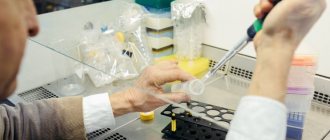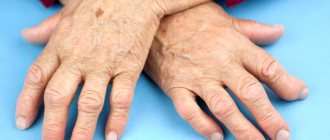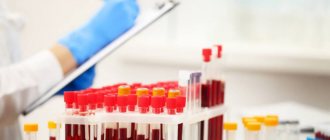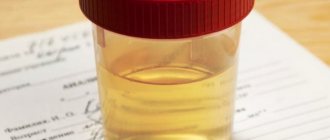The human immune system protects him from infections and pathological microorganisms. Immunoglobulins are antibodies that participate in local immunity. Immunoglobulins are produced by the body in response to the introduction of bacteria, viruses, fungi, and various foreign agents. Using an analysis of the level of antibodies in the blood, autoimmune diseases, allergic reactions and other pathological processes in the body are diagnosed.
In the laboratory of the Yusupov Hospital, a patient can undergo blood tests to determine antibodies to allergens, take immunological tests for markers of autoimmune diseases, undergo other tests, and receive advice from a highly qualified specialist.
Immunoglobulins A, M, G
Immunoglobulins are protein molecules that are produced by B lymphocytes. Immunoglobulins can not only be found in human blood - they attach to the surfaces of damaged cells that are foreign to the body, which are recognized as foreign agents. Immune antibodies are divided into five classes - IgA, IgG, IgM, IgD, IgE. In diagnostic studies, the greatest importance is attached to immunoglobulins IgG, IgA, IgM. During research, their qualitative and quantitative content is determined. The first determines the presence of infection in the blood, the second test determines the level of antibodies in the patient’s blood. For each infection, there is a certain norm for the level of antibodies M and G in the blood; some infections are not accompanied by an increase in the level of immunoglobulins.
Using an immunoglobulin antibody test, infectious infection is determined at the earliest stage of the disease - this allows for complete control of the disease and diagnostic efficiency. Immunoglobulins belong to local, humoral immunity, which works later than cellular immunity. Cellular immunity (T-lymphocytes) is the first to begin to fight foreign agents. If the fight against cellular immunity is not effective enough, the body activates humoral immunity - the production of immunoglobulins increases. The production of immunoglobulins does not always increase due to the appearance of a protein of infectious origin in the blood; in many cases, other reasons contribute to this:
- Rhesus or group incompatibility of the blood of mother and fetus.
- autoimmune disease.
- allergic disease.
Immunoglobulins A (IgA) make up about 15% of blood serum protein, are involved in the protection of mucous membranes (gastrointestinal tract, respiratory tract, urogenital mucous membranes), protect against pathogenic agents and toxins.
Expert opinion
Author: Elina Viktorovna Aranovich
Therapist, cardiologist, oncologist
An increase in immunoglobulins in the blood most often indicates a response of the immune system to an infectious infection. The analysis determines the stage of the disease and methods of its treatment. However, an increase in immunoglobulins is not always associated with infection. The main task of doctors is to conduct a differential diagnosis of conditions and determine the cause of elevated antibody levels. The information content of the method is 80-90%. This allows doctors to rely on its results with confidence.
Diagnosis of immunoglobulin concentrations is prescribed by therapists, allergists, immunologists, oncologists and other doctors who suspect a malfunction of the immune system. Immunoglobulin indicators are informative when making various diagnoses. In this regard, the number of specialists who are competent to prescribe this examination is increasing. Immunoglobulins are often prescribed as part of complex diagnostics. Based on the results obtained, doctors at the Yusupov Hospital select the appropriate treatment.
IgM below normal
There are congenital (rarely), acquired, and also caused by other reasons IgM deficiency. Although it is impossible to determine the specific type of immunoglobulin M deficiency based on the analysis, medical practice has proven that:
- congenital deficiency is a consequence of: Bruton's disease (immunodeficiency due to gene mutation);
- selective (selective) IgM deficiency;
- monoclonal gammopathy not associated with the IgM type;
- treatment with cytostatics or radiotherapy;
Immunoglobulins M and G
Immunoglobulins type M (IgM) are the largest antibodies of all protein molecules. They do not penetrate the placental barrier and do not affect the fetus. Antibodies of this type are found in blood serum and make up about 10% of the total protein. Immunoglobulins M are the first to be activated when a foreign agent appears in the blood and serve as the first sign of infectious diseases, including TORCH infections.
Immunoglobulin G (IgG) makes up about 75% of all antibodies in the human body. Immunoglobulins G penetrate the placental barrier and provide immunity to the newborn for several months after birth. Antibodies G and M of this type belong to the secondary immune response, are produced later than antibodies of type M, and can be directed to any type of antigen. Immunoglobulin G tests are carried out to diagnose hepatitis C and various infectious diseases. Antibodies G remain in the human blood throughout life and serve to protect the body from many infections.
Type M immunoglobulins are a marker of primary infection with the herpes simplex virus and indicate an exacerbation or chronic course of the disease. When infected with herpes, immunoglobulin G begins to be produced later than immunoglobulin M, but remains in the patient’s blood for the rest of his life. Immunoglobulins M are an indicator of HIV infection at an early stage of the disease, provided that highly sensitive tests are used. The level of immunoglobulin M increases within a month after infection, then remains for no more than a month. In case of HIV infection, immunoglobulin G remains in the blood for several years and serves as the main indicator for diagnosing HIV infection.
Make an appointment
Normal for IgM. Factors of influence
The following reference values have been established for immunoglobulin M:
| Age | Floor | IgM indicators , g/l |
| 0 – 3 months | Male/female | 0,06 – 0,21 |
| 3 – 12 months | Male | 0,17 – 1,43 |
| Female | 0,17 – 1,5 | |
| 1 – 12 years | Male | 0,41 – 1,83 |
| Female | 0,47 – 2,4 | |
| Over 12 years old | Male | 0,22 – 2,4 |
| Female | 0,33 – 2,93 |
Note: the data provided cannot be used for self-diagnosis and self-treatment. Only a qualified specialist should interpret the results and prescribe treatment.
The following factors may affect the test result:
- violation of the rules for preparing for analysis by the patient;
- taking immunomodulators during the 6 months preceding the procedure;
- drug treatment with hormones and some other medications;
- radiotherapy (irradiation) or chemotherapy;
- diseases of the urinary system (chronic renal failure, damage to the glomeruli of the kidneys);
- massive burns of the body surface;
- multiple injuries;
- recent operations;
- chronic intestinal pathologies (Crohn's disease, ulcerative colitis).
Analysis for immunoglobulins M and G
Tests for immunoglobulins M and G can accurately indicate the presence of an infectious or bacterial infection. The following clinical studies are being conducted:
- radioimmunoassay;
- linked immunosorbent assay;
- RPHA – indirect hemagglutination reaction;
- RMP – microprecipitation reaction;
- RIF – immunofluorescence reaction.
All studies serve for the comprehensive detection of antibodies and antigens that cause the growth of immunoglobulins. There are other methods for diagnosing diseases using immunoglobulins.
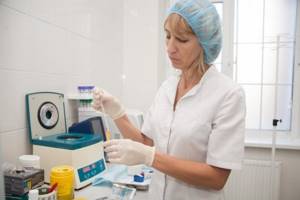
Preparation for IgM analysis
Preparatory measures for collecting blood from a vein in an adult or from the umbilical cord in a newborn are standard:
- Blood collection is carried out in the morning and strictly on an empty stomach (a period of overnight fasting of at least 10-12 hours). You are allowed to drink only clean, still water;
- 3-4 hours before the procedure, smoking and/or using nicotine substitutes (patch, spray, chewing gum) is prohibited;
- on the eve of the analysis, you should not drink alcohol, drugs, or energy drinks;
- the day before the test, you need to protect yourself from intense physical activity and emotional experiences;
- it is also not advisable to visit baths and saunas the day before the analysis;
- Before venipuncture, the patient must inform the doctor about all current courses of therapy, taking vitamins, etc.
Other tests to assess immunity
- Total immunoglobulin IgE
- Immunoglobulin IgA
- Immunoglobulin IgG
- Interleukins 1, 6, 8, 10
- TNF (tumor necrosis factor)
Indications for the study
Doctors at the Yusupov Hospital determine IgM immunoglobulin in elderly patients to assess the degree of immunodeficiency. A blood test from the umbilical cord is performed if prenatal infections are suspected. Determining the concentration of immunoglobulin m is necessary for patients suffering from rheumatoid arthritis and autoimmune diseases.
Malignant neoplasms, chronic hepatitis, liver cirrhosis, Waldenström's macroglobulinemia are indications for studying the concentration of IgM immunoglobulin. The test is done to check kidney function.
Determination of the level of immunoglobulins M
To test the content of immunoglobulin M, patients undergo venous blood sampling. When performing venipuncture, the medical staff of the Yusupov Hospital strictly observes the rules of asepsis and antisepsis. Blood is drawn into an empty tube or one containing a gel (to obtain serum).
On the eve of the study, the doctor stops medications that affect the level of immunoglobulins. After the blood is drawn, the patient can continue taking medications. In order for the results of the study to correspond to reality, the patient needs to prepare:
- refrain from eating for 12-14 hours before the test (you are allowed to drink water;
- during the three days preceding the study, do not drink alcohol;
- Stop smoking 2 hours before blood sampling.
The results of the study may be affected by the use of drugs and certain medications (dextran, gold preparations). The blood test is done within 4 hours. In order to determine the level of immunoglobulin M and get advice from an immunologist, call the clinic. The contact center of the Yusupov Hospital is open 24 hours a day, 7 days a week.
Should you always trust test results?
The result largely depends on the set of antigens that the developers used. If the selected antigens are not specific enough, proteins produced in response to other pathogens, such as related coronaviruses that cause the common cold, will latch on to them. In this case, the test gives a false positive result.
There are also false negative results - when a person has antibodies to an antigen that is not presented in the test. For example, this happens with viruses that have been discovered recently, as in the case of SARS-CoV-2. A false negative result can also occur when the blood was taken too early and there are not enough antibodies in it yet.
How to choose a quality antibody test?
Look at the sensitivity and specificity rates. Sensitivity is the agreement between positive test results and actual diagnoses. Specificity is the ability of a test to detect exactly those antibodies that relate to a specific pathogen. A test that is not sensitive enough may miss some cases, while a test that is not specific enough may suspect the virus in those who do not have it.
According to the results of a recent meta-analysis, the ELISA test, an enzyme-linked immunosorbent test, turned out to be the most reliable in determining antibodies to SARS-CoV-2. Its specificity is 99% and sensitivity is 90–94%. It is done in a laboratory and takes one to two days. The ICA (immunochromatographic) rapid test is less accurate, but it takes about ten minutes. Sensitivity/specificity may be different for different types of antibodies.
It is important to remember that the antibody test does not show the presence of the virus, but only the body’s possible reaction to it. The WHO (World Health Organization) considers the PCR test to be the most accurate and reliable method for diagnosing a viral infection. It allows you to detect the presence of genetic material of the virus in the blood. Remember that in making a final diagnosis, it is not the test that is decisive, but the clinical picture.
How is an antibody test done?
To detect antibodies, tests use antigens - areas on the surface of the virus to which these same antibodies bind. They are fixed in the wells of special tablets, or dies, and the patient’s blood is added to the wells. Staining then reveals the antibodies that would have attached to the antigens. If the sample changes color, this should mean that antibodies are present.
Rapid antibody tests are typically used to provide a simple yes/no result. They have two lines, like a pregnancy test. There are also those who look separately for proteins of classes M (which are formed during illness) and G (which remain in the blood after recovery). In this case, there are already three stripes in the test.
There are also quantitative tests. They already make it possible to determine not only the presence of antibodies, but also their concentration. It can be used to judge both the state of the immune system and the stage of the infectious process: is it in an acute form or is it heading towards recovery. To conduct quantitative tests, developers build on the established antibody norm, which corresponds to different stages.
